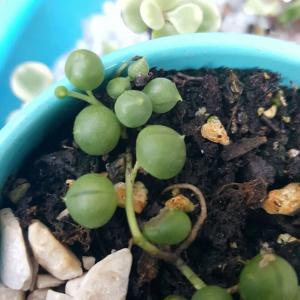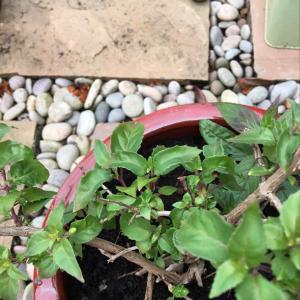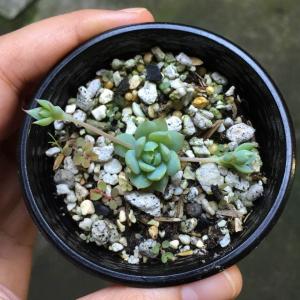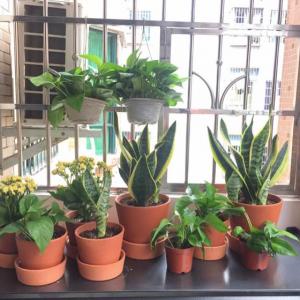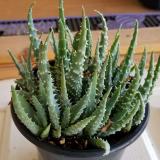文章
Colorful
2017年05月23日
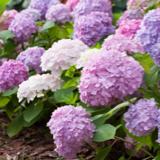
You love growing plants indoors, but they die soon (or you kill them)? This won’t happen again if you avoid these 9 mistakes!
Having plants in your house is like a baby to care. There are many things (if you’re new) you do not know when you plan to keep a plant in the house or the garden. If you are wondering WHY YOUR INDOOR PLANTS ARE DYING even after taking so much care and extra pampering, then there are some mistakes that you are doing. Here are the nine little (or the BIGGEST) mistakes which can kill your plant. So avoid doing them!
1. Keeping the plant in a location that is not suitable

Every plant has its specific needs, do’s and don’t do’s. If you don’t know what they are, acquire the knowledge from a florist, books or from the best place, the internet (consider our website)! Some plants are very specific with their placement indoor or outdoor. Placing them in an unsuitable location is certainly kill them sooner or later, quickly or gradually.
Mostly the plants growing indoors die due to this reason. You must read what a plant needs before you seek a place for it. Some plants require shade, indirect light or direct sunlight, while some need moisture. If a plant needs more level of moisture, then keep it in a shaded area. If not done so, all the moisture in the soil will dry up, and this will certainly kill the plant.
2. Changing the location to and fro
Plants adjust to the spot where they kept for a while, either at home or outdoors. When they moved often, it becomes difficult for them to adapt quickly to the different conditions of the new environment. Also, moving the plants frequently can hurt the growth of your houseplant.
3. Wrong soil
We say– Soil is the key! And when it comes to growing plants indoors, you can’t compromise with soil. A soilless potting mix is what we suggest. You can also make your own or choose high quality, organic soil mix.
Make sure that the soil you mix or buy is according to your plant’s needs. Some plants do better in moisture retaining, dense soil, while other plants, such as cacti, need light, fast-draining soil with high sand and peat content, to prevent root rot.
4. Overwatering

Even the experienced gardener make this mistake, this is the problem with container gardening. People who are new to gardening or growing plants do this– they think that giving more water to the plant will keep it healthy and let it grow faster. However, especially indoors, where the sun is scarce, the situation is different. Keeping plants on a little bit drier side is a good idea but if the plant you’re growing is a moisture loving plant then keep the soil slightly moist.
It is recommended that you do the research about the watering needs of your plant. Also, the most important factor that decides the watering requirements of a plant is the climate in which you’re growing it. Usually indoors, watering the plants only once a week should be enough though some of the low maintenance plants require even less water. It’s a good idea to feel the soil in every three days and when you water, water the plants thoroughly.
5. Keeping plants in too much or too little light
It is true that plants need light, but indoor plants are tender, low sunlight plants and exceeding their light requirement can kill them. It is always better to know about your plant before placing it anywhere. Some plants require little light for healthy growth. If they are supplied with more light, then this can kill or debilitate them.
6. Exposing to extreme temperatures
Indoor plants are indoor plants because they like indoor conditions and unvarying temperature, there are only a few that like high or low temperature than normal average room temperature. The safest daytime temperature for indoor plants is 65-75 F (18-24 C) or somewhere around it, whereas, during night time, fall in 5-10 F in temperature is optimum. Moderate temperature works well for houseplants and having a constant temperature leads to healthy growth.
7. Keeping the plant rootbound

If you have a houseplant for a long time and you do not re-pot it then it, becomes bound to the pot you have planted it in. In optimum conditions, (if the plant is not slow-growing) plants outgrow the pot within a year or two. When leaves start to turn yellow or if you see the roots popping out, it is the signal to re-pot the plant. This indication is due to less space and freshness to grow healthy. When sending Plants for housewarming, you tend to gift it is small pot, but later it can be repotted in larger spaces.
Leaves turning yellow are the indication of insufficient space, water, nutrients and air. So when you see these signs, take the right step and re-pot the plant in a larger space.8. Neglecting the plants
Many of us, plant the plants and forget about them. Underwatering is one of the consequences of it. Neglecting plants is the reason why most people kill the indoor plants. Not looking at plants suffering from pests or diseases, missing to prune, no regular fertilization. All this must be avoided.
9. Not cleaning the leaves
Is it important to clean the leaves of the houseplants? Well, yes! For two reasons you should clean the leaves of your houseplants. First, it makes them look attractive. Second, it makes them HEALTHY! Already, the sun is scarce indoors, and the layer of dust accumulated on the foliage of houseplants contributes to blocking the direct or indirect sunlight and reduce the plant’s ability to photosynthesize. And a result you get a weak and stressful plant. Gardening Know How has an important article on this. Check out!
Having plants in your house is like a baby to care. There are many things (if you’re new) you do not know when you plan to keep a plant in the house or the garden. If you are wondering WHY YOUR INDOOR PLANTS ARE DYING even after taking so much care and extra pampering, then there are some mistakes that you are doing. Here are the nine little (or the BIGGEST) mistakes which can kill your plant. So avoid doing them!
1. Keeping the plant in a location that is not suitable

Every plant has its specific needs, do’s and don’t do’s. If you don’t know what they are, acquire the knowledge from a florist, books or from the best place, the internet (consider our website)! Some plants are very specific with their placement indoor or outdoor. Placing them in an unsuitable location is certainly kill them sooner or later, quickly or gradually.
Mostly the plants growing indoors die due to this reason. You must read what a plant needs before you seek a place for it. Some plants require shade, indirect light or direct sunlight, while some need moisture. If a plant needs more level of moisture, then keep it in a shaded area. If not done so, all the moisture in the soil will dry up, and this will certainly kill the plant.
2. Changing the location to and fro
Plants adjust to the spot where they kept for a while, either at home or outdoors. When they moved often, it becomes difficult for them to adapt quickly to the different conditions of the new environment. Also, moving the plants frequently can hurt the growth of your houseplant.
3. Wrong soil
We say– Soil is the key! And when it comes to growing plants indoors, you can’t compromise with soil. A soilless potting mix is what we suggest. You can also make your own or choose high quality, organic soil mix.
Make sure that the soil you mix or buy is according to your plant’s needs. Some plants do better in moisture retaining, dense soil, while other plants, such as cacti, need light, fast-draining soil with high sand and peat content, to prevent root rot.
4. Overwatering

Even the experienced gardener make this mistake, this is the problem with container gardening. People who are new to gardening or growing plants do this– they think that giving more water to the plant will keep it healthy and let it grow faster. However, especially indoors, where the sun is scarce, the situation is different. Keeping plants on a little bit drier side is a good idea but if the plant you’re growing is a moisture loving plant then keep the soil slightly moist.
It is recommended that you do the research about the watering needs of your plant. Also, the most important factor that decides the watering requirements of a plant is the climate in which you’re growing it. Usually indoors, watering the plants only once a week should be enough though some of the low maintenance plants require even less water. It’s a good idea to feel the soil in every three days and when you water, water the plants thoroughly.
5. Keeping plants in too much or too little light
It is true that plants need light, but indoor plants are tender, low sunlight plants and exceeding their light requirement can kill them. It is always better to know about your plant before placing it anywhere. Some plants require little light for healthy growth. If they are supplied with more light, then this can kill or debilitate them.
6. Exposing to extreme temperatures
Indoor plants are indoor plants because they like indoor conditions and unvarying temperature, there are only a few that like high or low temperature than normal average room temperature. The safest daytime temperature for indoor plants is 65-75 F (18-24 C) or somewhere around it, whereas, during night time, fall in 5-10 F in temperature is optimum. Moderate temperature works well for houseplants and having a constant temperature leads to healthy growth.
7. Keeping the plant rootbound

If you have a houseplant for a long time and you do not re-pot it then it, becomes bound to the pot you have planted it in. In optimum conditions, (if the plant is not slow-growing) plants outgrow the pot within a year or two. When leaves start to turn yellow or if you see the roots popping out, it is the signal to re-pot the plant. This indication is due to less space and freshness to grow healthy. When sending Plants for housewarming, you tend to gift it is small pot, but later it can be repotted in larger spaces.
Leaves turning yellow are the indication of insufficient space, water, nutrients and air. So when you see these signs, take the right step and re-pot the plant in a larger space.8. Neglecting the plants
Many of us, plant the plants and forget about them. Underwatering is one of the consequences of it. Neglecting plants is the reason why most people kill the indoor plants. Not looking at plants suffering from pests or diseases, missing to prune, no regular fertilization. All this must be avoided.
9. Not cleaning the leaves
Is it important to clean the leaves of the houseplants? Well, yes! For two reasons you should clean the leaves of your houseplants. First, it makes them look attractive. Second, it makes them HEALTHY! Already, the sun is scarce indoors, and the layer of dust accumulated on the foliage of houseplants contributes to blocking the direct or indirect sunlight and reduce the plant’s ability to photosynthesize. And a result you get a weak and stressful plant. Gardening Know How has an important article on this. Check out!
2
2
文章
Colorful
2017年05月23日

New to growing plants and no idea what you should grow indoors? Learn about these 15 Best Houseplants for Beginners. They all are easy to grow!
Potted houseplants provide a lavish look and can be used to decorate the interior at low cost. Also, they create positive impact and many of them purify the air. But what you’ll do if you don’t have much knowledge about growing plants and the houseplants that are best to grow? Simple! Learn about these 15 Best Houseplants for Beginners! They are easy to grow and tolerate poor conditions.
1. Snake Plant
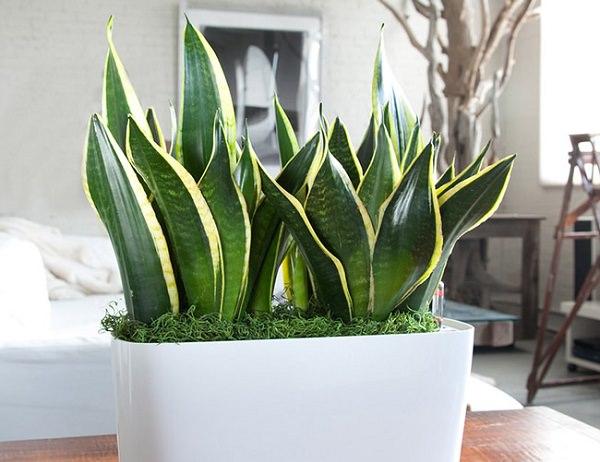
Snake plant is one of the best plants for the beginners. Easy to grow and hard to kill, it can be grown in low light and need to be watered occasionally. Snake plant also removes toxins from the air– All this makes it a perfect houseplant for beginners.
2. Heartleaf Philodendron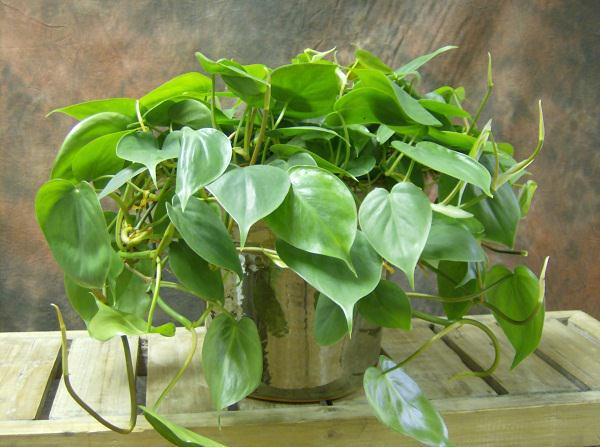
Philodendron scandens is extremely easy to grow and great for beginners. It needs a moderate amount of light and prefers the soil to dry out between watering spells.
3. Spider Plant
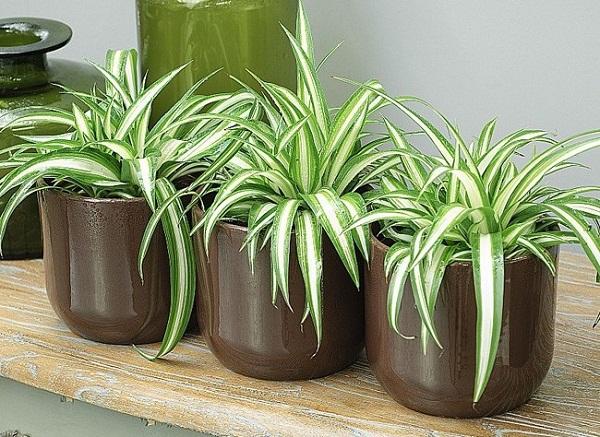
One of the most popular houseplants. Its popularity is due to its toughness and the ease of growing and maintenance. The plant can easily adapt to almost any condition. Keep the plant in a bright spot and maintain slight moisture in the soil and it will grow happily.
4. Peace Lily

The peace lily is among the easiest plants to grow indoors. It can tolerate a wide range of lighting conditions, and needs only moderate watering. With graceful curving leaves and white flower that rise up from the dark foliage, peace lily looks exotic and elegant.
5. English Ivy
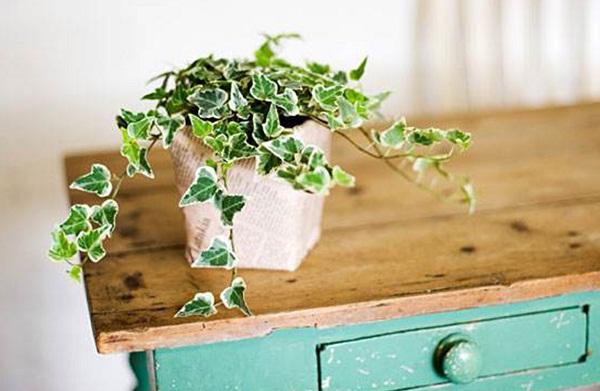
English Ivy is very hardy and easy to grow. Keep the pot in a spot that receives bright indirect sun and plant it in a container that is wide and shallow rather than narrow and deep.
6. Succulents and Cactus

Succulents and cacti are ideal for those who forget to water and care for plants. They are very adaptable and can survive many adverse conditions.
They need to be placed on a bright spot and a well-drained soil with little water.
7. Lucky Bamboo
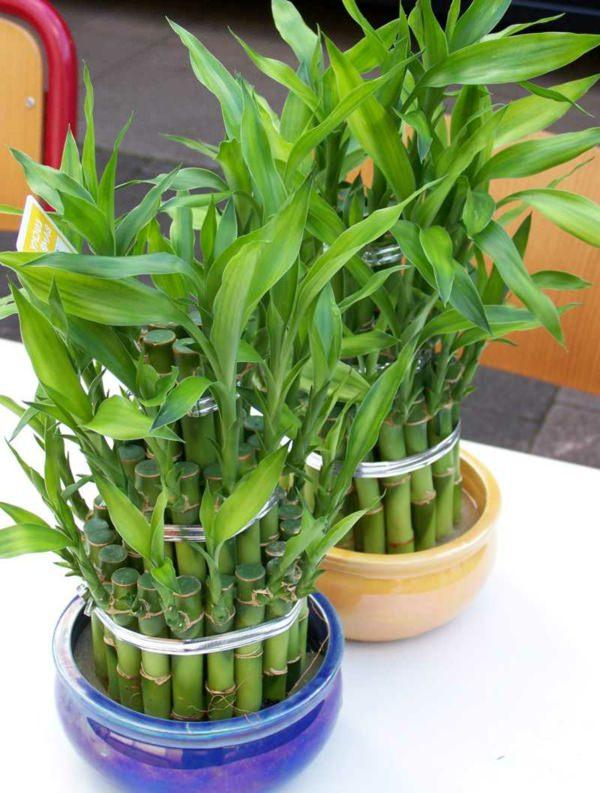
Lucky bamboo is not a bamboo, but a plant belongs to Dracaena genus. It is an easy-care houseplant. Just provide it abundant water and it’ll grow well even in indirect light. Protect the plant from cold drafts and provide iron fertilizer occasionally.
8. Jade Plant
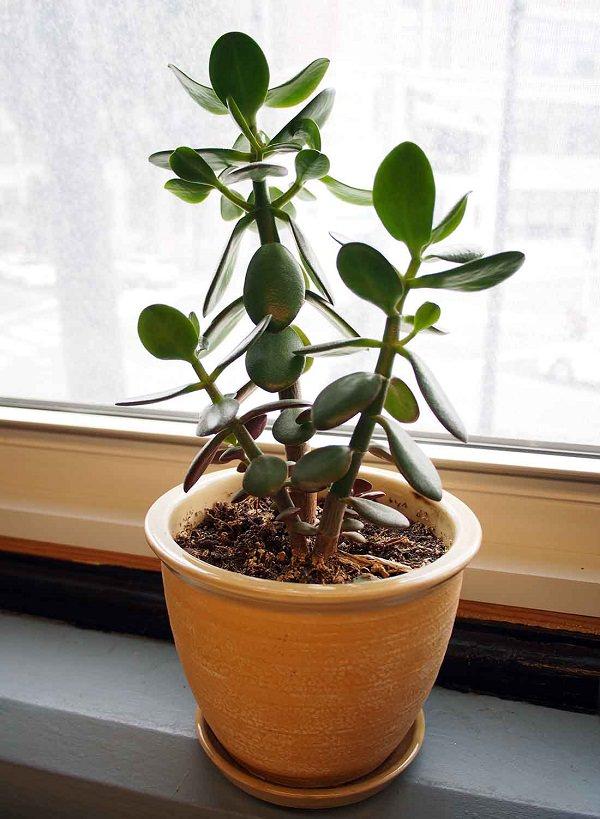
Jade plant is a succulent and is probably one of the best houseplants for beginners. When grown indoors, a jade plant can grow up to a size of a small shrub. Keep the plant in a spot that receives partial or indirect sunlight from having a healthy specimen.
9. Cast Iron Plant
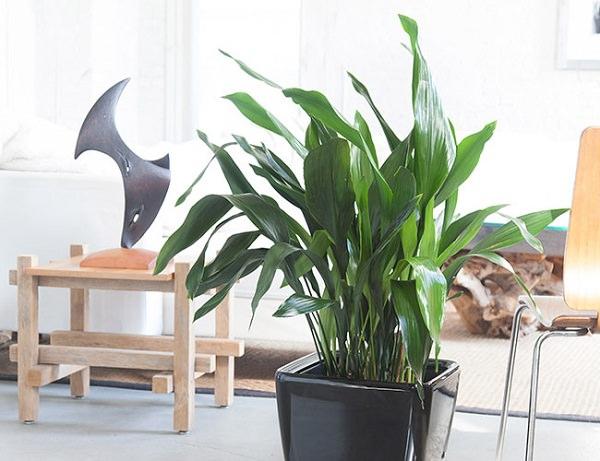
As the name suggest, one of the toughest plants that make it ideal for beginners. Cast-iron plant can withstands neglect, low light, low humidity, and a wide range of temperatures. It prefers moist soil.
10. Peperomia

Credit: Houseplants Expert
Another good plant for beginners is Peperomia. Peperomia is small striking houseplant that is available in different colors and shapes. Peperomia likes slightly moist soil and humidity but watering should be reduced in winter.
11. ZZ Plant
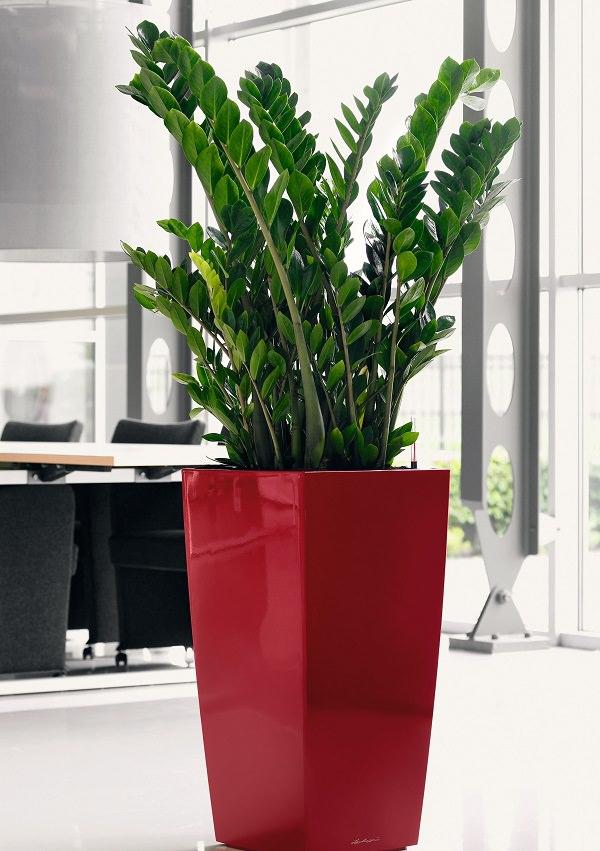
This super-tough plant is high resistant to adverse conditions like drought and low light. The plant prefers bright to moderate indirect light and well-drained soil. ZZ plant can do fine without fertilizer, but if you would like, you can fertilize the plant with half strength general fertilizer one to two times a year in the summer months.
12. Pothos (Devil’s Ivy)
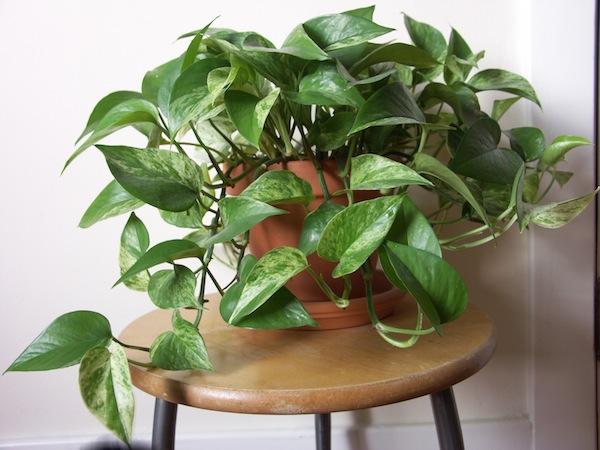
Plants of the pothos family are easy to grow and become great houseplants for beginners. This attractive and durable vine prefers bright indirect light and a draft free place. It can grow in low light and needs moist soil.
13. Dracaena
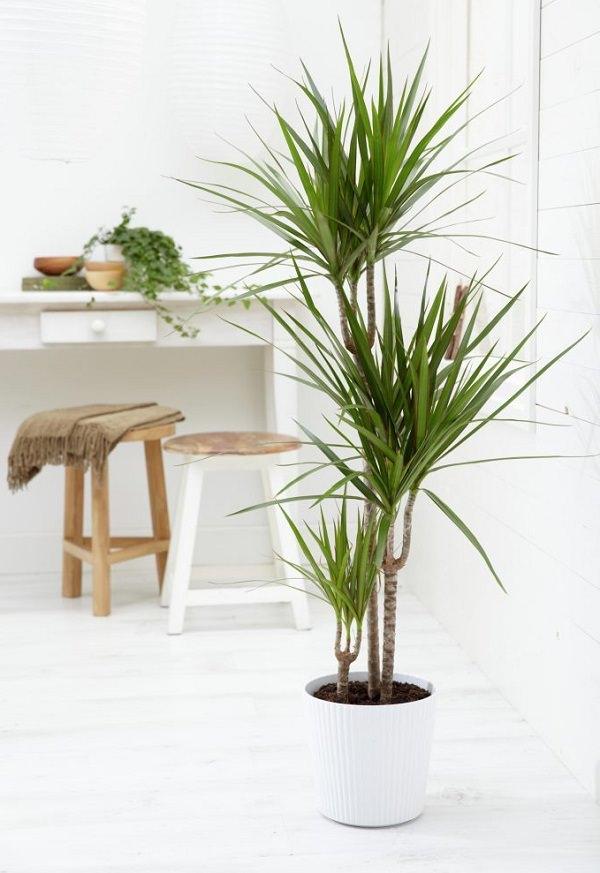
There are many varieties of Dracaena genus that are hardy houseplants, Dracaena marginata, Dracaena fragrans are among the most popular and easy to grow plants. This beautiful houseplant needs occasional pruning and regular watering. Keep the plant away from direct sun and avoid overwatering.
14. Bromeliads
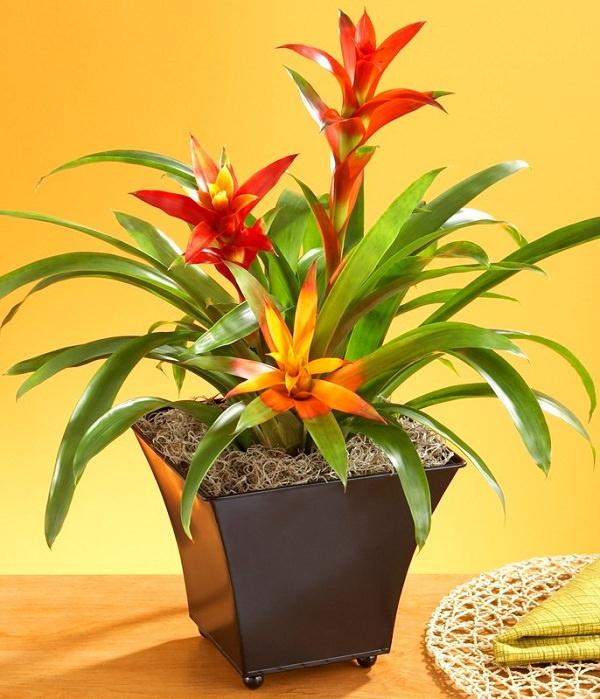
Bromeliad is a perfect plant to grow indoors, most of the varieties of this plant thrive easily indoors. Although it is difficult to make it bloom, there are many varieties that have beautiful foliage that makes an attractive display.
15. Rubber Plant
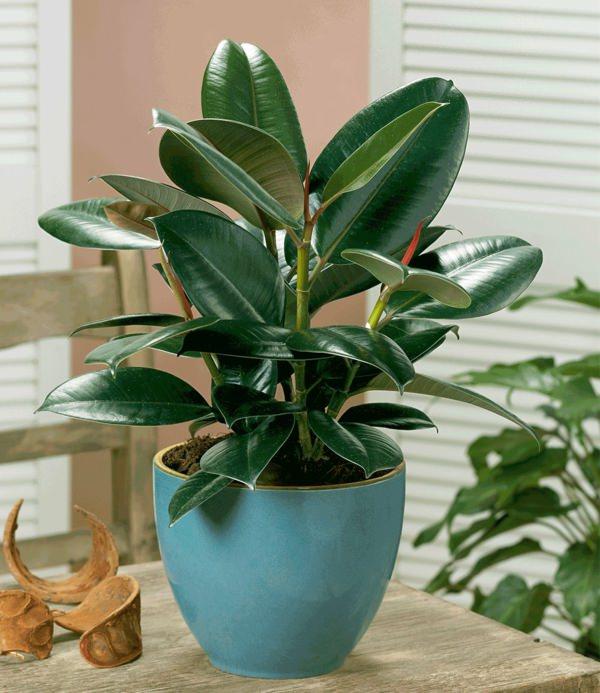
Rubber plant is a large houseplant that can become a focal point to any room. Low maintenance and easy to grow. Keep it in a well-lit position in your home and allow the soil to dry out between watering spells. Besides the ornamental aspect, rubber plant is also an air purifying plant.
Potted houseplants provide a lavish look and can be used to decorate the interior at low cost. Also, they create positive impact and many of them purify the air. But what you’ll do if you don’t have much knowledge about growing plants and the houseplants that are best to grow? Simple! Learn about these 15 Best Houseplants for Beginners! They are easy to grow and tolerate poor conditions.
1. Snake Plant

Snake plant is one of the best plants for the beginners. Easy to grow and hard to kill, it can be grown in low light and need to be watered occasionally. Snake plant also removes toxins from the air– All this makes it a perfect houseplant for beginners.
2. Heartleaf Philodendron

Philodendron scandens is extremely easy to grow and great for beginners. It needs a moderate amount of light and prefers the soil to dry out between watering spells.
3. Spider Plant

One of the most popular houseplants. Its popularity is due to its toughness and the ease of growing and maintenance. The plant can easily adapt to almost any condition. Keep the plant in a bright spot and maintain slight moisture in the soil and it will grow happily.
4. Peace Lily

The peace lily is among the easiest plants to grow indoors. It can tolerate a wide range of lighting conditions, and needs only moderate watering. With graceful curving leaves and white flower that rise up from the dark foliage, peace lily looks exotic and elegant.
5. English Ivy

English Ivy is very hardy and easy to grow. Keep the pot in a spot that receives bright indirect sun and plant it in a container that is wide and shallow rather than narrow and deep.
6. Succulents and Cactus

Succulents and cacti are ideal for those who forget to water and care for plants. They are very adaptable and can survive many adverse conditions.
They need to be placed on a bright spot and a well-drained soil with little water.
7. Lucky Bamboo

Lucky bamboo is not a bamboo, but a plant belongs to Dracaena genus. It is an easy-care houseplant. Just provide it abundant water and it’ll grow well even in indirect light. Protect the plant from cold drafts and provide iron fertilizer occasionally.
8. Jade Plant

Jade plant is a succulent and is probably one of the best houseplants for beginners. When grown indoors, a jade plant can grow up to a size of a small shrub. Keep the plant in a spot that receives partial or indirect sunlight from having a healthy specimen.
9. Cast Iron Plant

As the name suggest, one of the toughest plants that make it ideal for beginners. Cast-iron plant can withstands neglect, low light, low humidity, and a wide range of temperatures. It prefers moist soil.
10. Peperomia

Credit: Houseplants Expert
Another good plant for beginners is Peperomia. Peperomia is small striking houseplant that is available in different colors and shapes. Peperomia likes slightly moist soil and humidity but watering should be reduced in winter.
11. ZZ Plant

This super-tough plant is high resistant to adverse conditions like drought and low light. The plant prefers bright to moderate indirect light and well-drained soil. ZZ plant can do fine without fertilizer, but if you would like, you can fertilize the plant with half strength general fertilizer one to two times a year in the summer months.
12. Pothos (Devil’s Ivy)

Plants of the pothos family are easy to grow and become great houseplants for beginners. This attractive and durable vine prefers bright indirect light and a draft free place. It can grow in low light and needs moist soil.
13. Dracaena

There are many varieties of Dracaena genus that are hardy houseplants, Dracaena marginata, Dracaena fragrans are among the most popular and easy to grow plants. This beautiful houseplant needs occasional pruning and regular watering. Keep the plant away from direct sun and avoid overwatering.
14. Bromeliads

Bromeliad is a perfect plant to grow indoors, most of the varieties of this plant thrive easily indoors. Although it is difficult to make it bloom, there are many varieties that have beautiful foliage that makes an attractive display.
15. Rubber Plant

Rubber plant is a large houseplant that can become a focal point to any room. Low maintenance and easy to grow. Keep it in a well-lit position in your home and allow the soil to dry out between watering spells. Besides the ornamental aspect, rubber plant is also an air purifying plant.
0
2
文章
Colorful
2017年05月23日

Take a look at these 19 Best low maintenance houseplants, if you’re new to growing plants indoors or find yourself lazy.
There are plenty of good things about having plants in the house. For starters, they clean up the air and smell wonderful. Secondly, they add a much-needed dash of color and accentuate the appeal of your interior.
1. Snake Plant
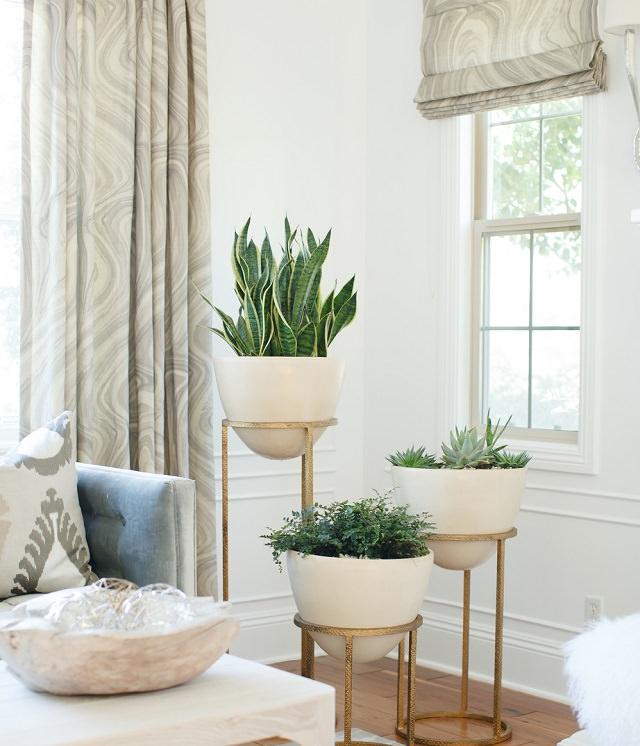
The snake plant is a low-maintenance succulent plant that thrives on neglect pretty well. If you have had little success with indoor gardening , do give the snake plant a try. All types of snake plant tolerate low light and prefer being potbound. The fact that it has thick and waxy leaves means it can withstand scarcity of water for prolonged periods of time. To put it simply, the snake plant is apt for lazy gardeners and two-week vacationers.
2. Tillandsia (Air Plants)
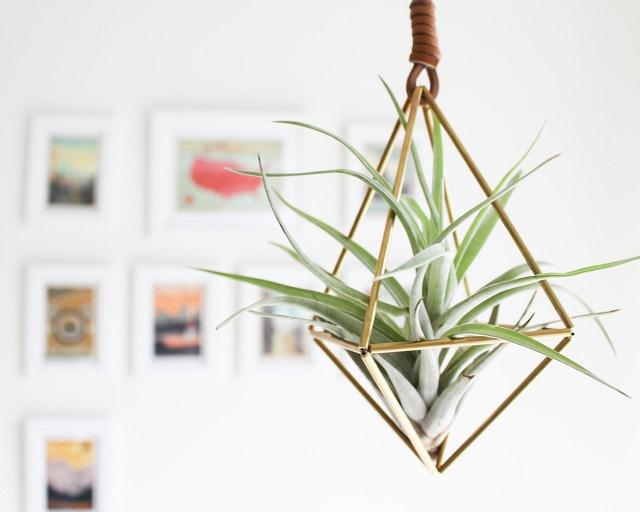
Tillandsia is a genus of air plants native to the deserts, forests and mountains of central and South America. Air plants are epiphyte, meaning they don’t need soil to grow. All you need is to mist or water them up once in a week. Some of the air plants also absorb dust– All this makes them interesting and low-maintenance houseplants. The air plants are a perfect choice for people who wish to add a touch of green to their home without much work.
3. Cast-Iron Plant

The cast-iron plant is true to its name- it’s literally indestructible. It can withstand extremes of conditions, including low light, low humidity, as well as a wide spectrum of temperatures. And it grows slowly, which means you don’t need to repot it often.
4. Kalanchoe

Kalanchoe is a genus of tropical succulent flowering plants, from the wide-leafed and bright ‘Flapjack’ to the compact Kalanchoe manginii or Kalanchoe blossfeldiana. Kalanchoes are easy to grow, all they ask for is a sunny spot and an occasional spritz of water. Both these varieties are architecturally interesting and last for so long with little attention from your end.
5. Philodendron
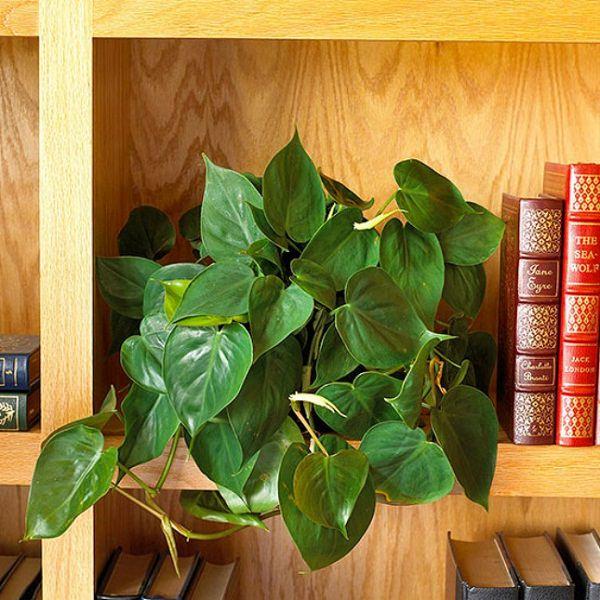
Philodendron is a fast-growing foliage houseplant with bottle-green heart-shaped leaves, similar to pothos. This plant is extremely durable and adapts well to low-light areas. Philodendron looks great in hanging baskets or when branches trailing down from above.
6. ZZ Plant
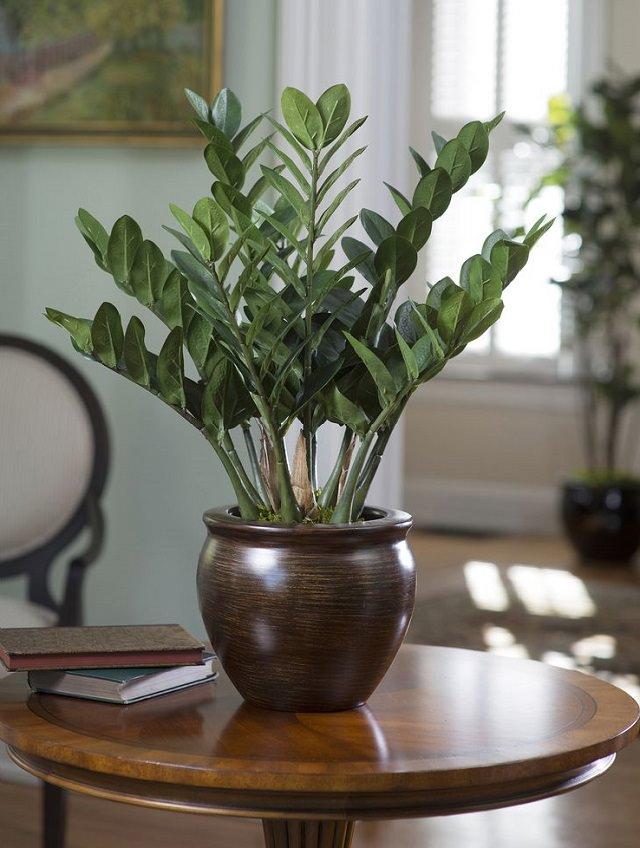
The ZZ plant is also known as the eternity plant as it lasts so long that it’s practically a challenge to kill it! Its fat succulent leaves are thick, fleshy leafstalks are so durable that they can be easily mistaken for plastic. Since the plant is a slow grower, you may want to purchase a large plant if in case you need a big specimen for your house.
7. Bromeliad
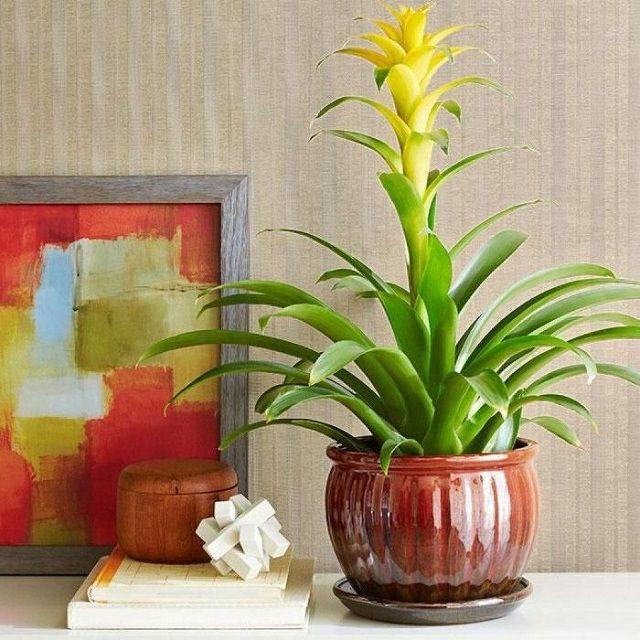
Bromeliad, like pineapple, belongs to the bromeliacea family. This plant produces a delicate pink inflorescence that is beautiful to look at. It lasts long too, and occasionally produces new side shoots that replace the original ones.
8. Jade Plant
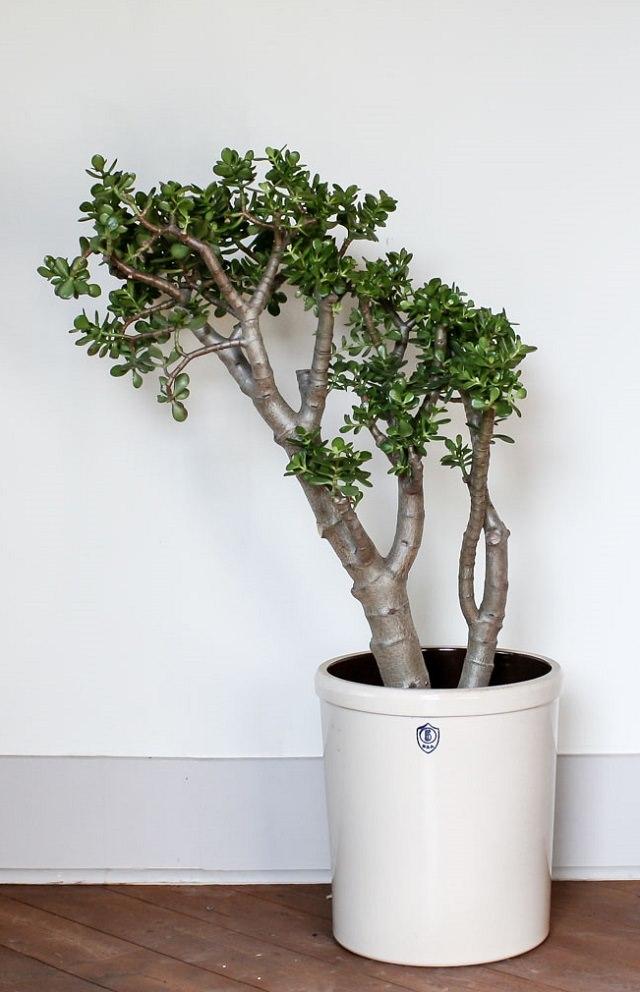
Native to South America, Jade is a low maintenance indoor plant. A succulent that retains water in its round, fleshy leaves. They thrive on neglect, so all you need to do is place them in a bright and airy spot and you’re done. As the thick trunk of jade plant easily gives it a mature look, it is also good for bonsai making.
Also Read: Best Plants and Trees for Bonsai
9. Succulents
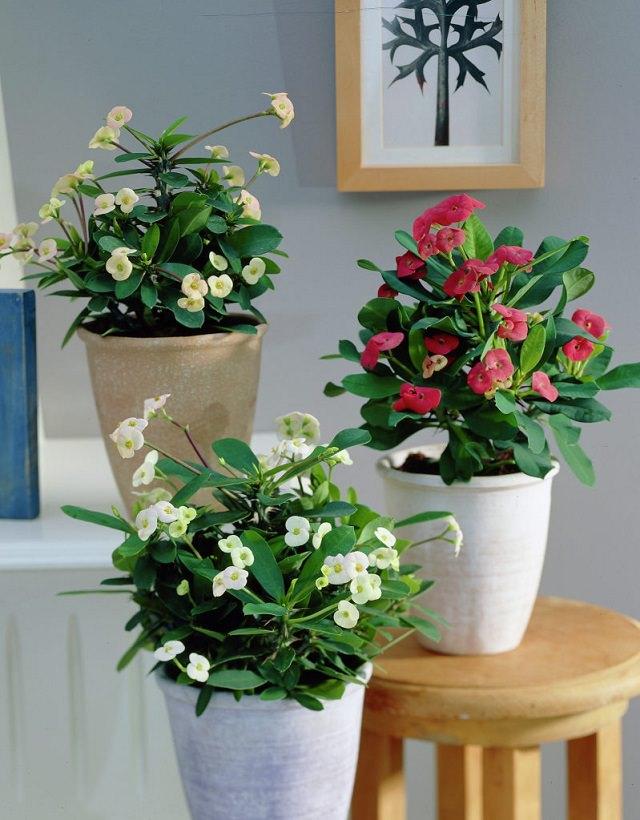
Whether its Crown of thorns or any other succulent most of them are the plants that are easy to grow indoors. Especially for those who forget to water the plants for days. If you’re interested in knowing more about the succulents that are easy to grow click here!
10. Pothos

Pothos is a fast-growing, leafy vine with striking variegated leaves that are tolerant to both irregular watering and low light conditions. The vine extends quickly, often leaving a 10-feet long, green trail over shelves or furniture. Though it’s not as drought-tolerant as many other plants in this list and demands some attention from you when it comes to watering.
11. Peace Lily

The peace lily is an easy-to-care houseplant that tolerates low light and low humidity really well and it seems like it is made for indoor conditions. Glossy, lance-shaped foliage with arched stems that surround the central flower spikes. It produces spoon-shaped blooms in summer usually but some varieties do blossom intermittently throughout the year. As an added bonus, it purifies noxious substances like formaldehyde and carbon monoxide from the air. If growing in a large pot peace lily can even go without water for a month. These plants thrive better on under-watering conditions.
12. Begonia
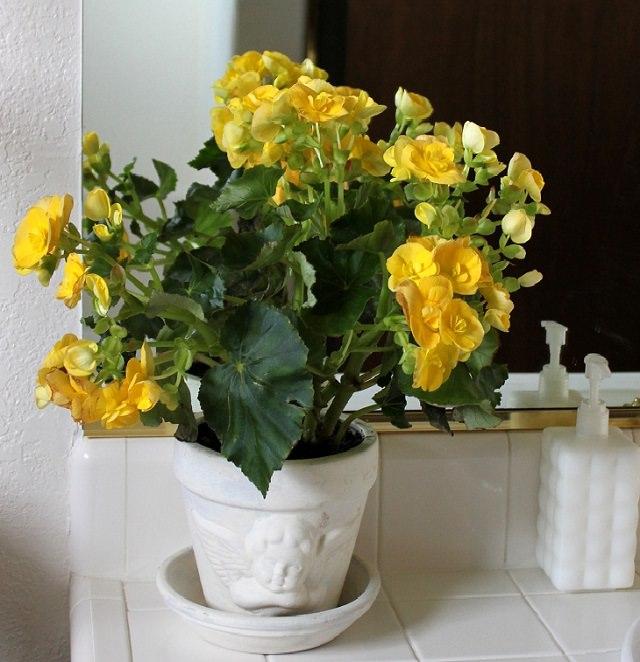
Begonias, with lush, green leaves and satiny flowers paint a pretty picture. Though they are more often thought of as outdoor plants, the fibrous and rhizomatous variants perform well indoors. They prefer humid environments, so you may want to water them 2-3 times a week in summer to make sure they stay healthy and green. They are not that fussy about light/temperature conditions. Bright, indirect sunlight works fine for them.
13. Aloe

Especially, Aloe Vera is one of the most multi-purpose houseplants in Aloe genus you can choose for indoor gardening. Its plump, spiraling leaves ooze out a soothing gel that can be used for burns and cuts. You can use it to relieve sunburns and even ingest its gel for a minty, cool feeling. Aloe loves to have some direct light and a moderate spritz of water every week or two.
Also Read: How to Care for an Aloe Plant
14. Boston Fern
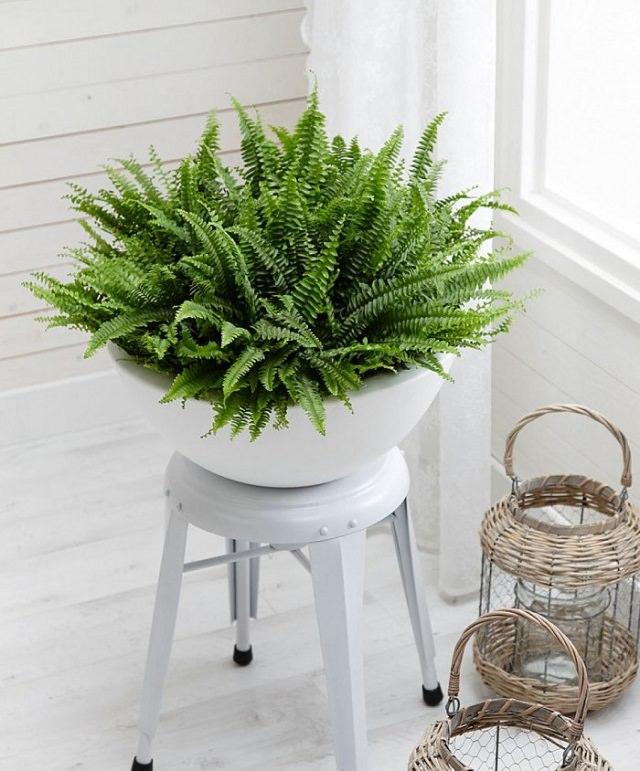
Renowned since the Victorian times, Boston fern is one of the most popular variants of fern. With its delicate, frilly leaves and lush, hanging fronds, it looks aesthetic when displayed in baskets hanging down from ceilings. Being the most drought-tolerant fern, it is easy to care for. All you have to do is to place it in a spot that gets indirect light, avoid dry air. Misting the plant in every few days also help by providing humidity.
15. Dracaena

The plants from Dracaena genus perform well as an indoor plant. They become great houseplants as they are tolerant to extreme indoor conditions. For instance, they survive well in under-watered soil. Additionally, they are not picky about light exposure. The young plants look great on tabletops, while the larger ones require sizable floor space improving the appearance of home and offices.
16. English Ivy
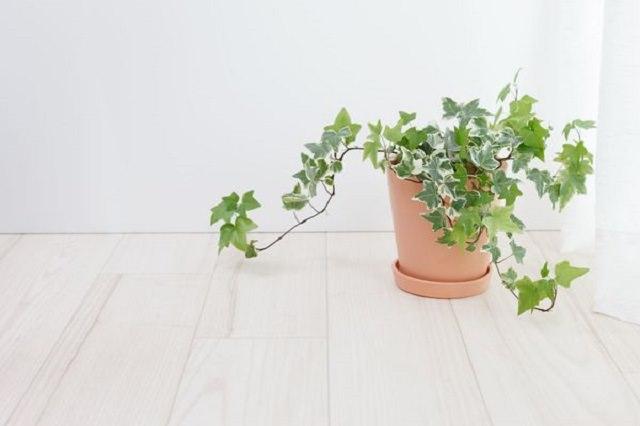
This plant is well known for its evergreen foliage. It is easy to maintain and needs as little as evenly moist soil and bright indirect light to grow well. The stems tend to grow long but can be easily controlled with pruning. For the best display, place your English ivy on a mantel where the stems can hang down luxuriantly.
17. Ponytail Palm

Contrary to its name, the ponytail palm isn’t a palm, in fact, it’s a succulent! AND; we love it. We listed it on our list of best succulents, easiest houseplants, and the best tall and large indoor plants. Don’t forget to check out these articles! It is a slow-growing plant, which means you don’t need to change the pot often. It performs best in sunny spots but never mind low lit areas receiving only bright indirect sunlight day long, also, the plant has low watering needs.
18. Spider Plant
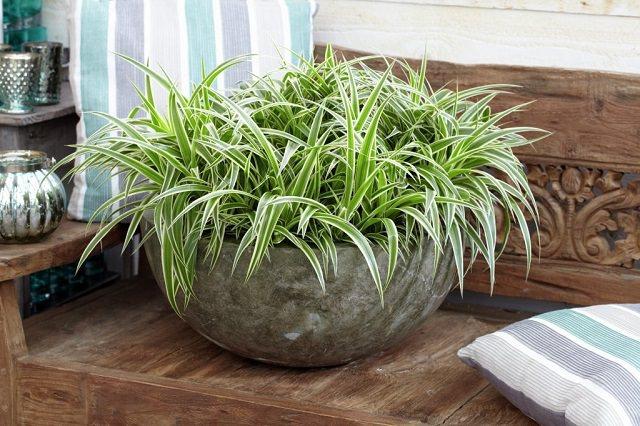
Spider plant is one of the most grown low maintenance houseplants. This forgiving plant doesn’t mind irregular watering and goes for weeks without water if grown in cool indoor conditions. Keeping the spider plant in low light conditions without direct sunlight is also possible.
Also Read: Plants that Grow without Sunlight
19. Rubber Tree Plant
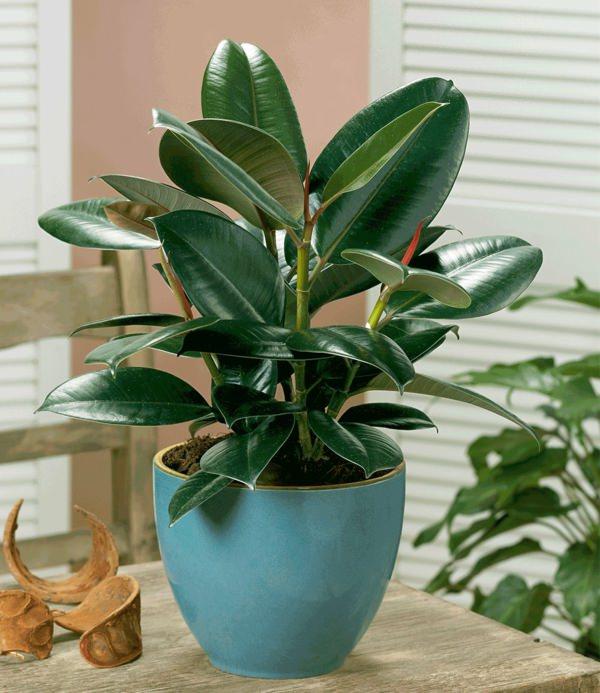
Rubber tree plant is an air purifying plant, it cleanses the formaldehyde. It is not difficult to grow and you can easily keep it in your home or office in a spot that is bright and receives a couple of hours of sunlight if possible. Avoid the exposure of the plant to the intense sun in afternoon.
There are plenty of good things about having plants in the house. For starters, they clean up the air and smell wonderful. Secondly, they add a much-needed dash of color and accentuate the appeal of your interior.
1. Snake Plant

The snake plant is a low-maintenance succulent plant that thrives on neglect pretty well. If you have had little success with indoor gardening , do give the snake plant a try. All types of snake plant tolerate low light and prefer being potbound. The fact that it has thick and waxy leaves means it can withstand scarcity of water for prolonged periods of time. To put it simply, the snake plant is apt for lazy gardeners and two-week vacationers.
2. Tillandsia (Air Plants)

Tillandsia is a genus of air plants native to the deserts, forests and mountains of central and South America. Air plants are epiphyte, meaning they don’t need soil to grow. All you need is to mist or water them up once in a week. Some of the air plants also absorb dust– All this makes them interesting and low-maintenance houseplants. The air plants are a perfect choice for people who wish to add a touch of green to their home without much work.
3. Cast-Iron Plant

The cast-iron plant is true to its name- it’s literally indestructible. It can withstand extremes of conditions, including low light, low humidity, as well as a wide spectrum of temperatures. And it grows slowly, which means you don’t need to repot it often.
4. Kalanchoe

Kalanchoe is a genus of tropical succulent flowering plants, from the wide-leafed and bright ‘Flapjack’ to the compact Kalanchoe manginii or Kalanchoe blossfeldiana. Kalanchoes are easy to grow, all they ask for is a sunny spot and an occasional spritz of water. Both these varieties are architecturally interesting and last for so long with little attention from your end.
5. Philodendron

Philodendron is a fast-growing foliage houseplant with bottle-green heart-shaped leaves, similar to pothos. This plant is extremely durable and adapts well to low-light areas. Philodendron looks great in hanging baskets or when branches trailing down from above.
6. ZZ Plant

The ZZ plant is also known as the eternity plant as it lasts so long that it’s practically a challenge to kill it! Its fat succulent leaves are thick, fleshy leafstalks are so durable that they can be easily mistaken for plastic. Since the plant is a slow grower, you may want to purchase a large plant if in case you need a big specimen for your house.
7. Bromeliad

Bromeliad, like pineapple, belongs to the bromeliacea family. This plant produces a delicate pink inflorescence that is beautiful to look at. It lasts long too, and occasionally produces new side shoots that replace the original ones.
8. Jade Plant

Native to South America, Jade is a low maintenance indoor plant. A succulent that retains water in its round, fleshy leaves. They thrive on neglect, so all you need to do is place them in a bright and airy spot and you’re done. As the thick trunk of jade plant easily gives it a mature look, it is also good for bonsai making.
Also Read: Best Plants and Trees for Bonsai
9. Succulents

Whether its Crown of thorns or any other succulent most of them are the plants that are easy to grow indoors. Especially for those who forget to water the plants for days. If you’re interested in knowing more about the succulents that are easy to grow click here!
10. Pothos

Pothos is a fast-growing, leafy vine with striking variegated leaves that are tolerant to both irregular watering and low light conditions. The vine extends quickly, often leaving a 10-feet long, green trail over shelves or furniture. Though it’s not as drought-tolerant as many other plants in this list and demands some attention from you when it comes to watering.
11. Peace Lily

The peace lily is an easy-to-care houseplant that tolerates low light and low humidity really well and it seems like it is made for indoor conditions. Glossy, lance-shaped foliage with arched stems that surround the central flower spikes. It produces spoon-shaped blooms in summer usually but some varieties do blossom intermittently throughout the year. As an added bonus, it purifies noxious substances like formaldehyde and carbon monoxide from the air. If growing in a large pot peace lily can even go without water for a month. These plants thrive better on under-watering conditions.
12. Begonia

Begonias, with lush, green leaves and satiny flowers paint a pretty picture. Though they are more often thought of as outdoor plants, the fibrous and rhizomatous variants perform well indoors. They prefer humid environments, so you may want to water them 2-3 times a week in summer to make sure they stay healthy and green. They are not that fussy about light/temperature conditions. Bright, indirect sunlight works fine for them.
13. Aloe

Especially, Aloe Vera is one of the most multi-purpose houseplants in Aloe genus you can choose for indoor gardening. Its plump, spiraling leaves ooze out a soothing gel that can be used for burns and cuts. You can use it to relieve sunburns and even ingest its gel for a minty, cool feeling. Aloe loves to have some direct light and a moderate spritz of water every week or two.
Also Read: How to Care for an Aloe Plant
14. Boston Fern

Renowned since the Victorian times, Boston fern is one of the most popular variants of fern. With its delicate, frilly leaves and lush, hanging fronds, it looks aesthetic when displayed in baskets hanging down from ceilings. Being the most drought-tolerant fern, it is easy to care for. All you have to do is to place it in a spot that gets indirect light, avoid dry air. Misting the plant in every few days also help by providing humidity.
15. Dracaena

The plants from Dracaena genus perform well as an indoor plant. They become great houseplants as they are tolerant to extreme indoor conditions. For instance, they survive well in under-watered soil. Additionally, they are not picky about light exposure. The young plants look great on tabletops, while the larger ones require sizable floor space improving the appearance of home and offices.
16. English Ivy

This plant is well known for its evergreen foliage. It is easy to maintain and needs as little as evenly moist soil and bright indirect light to grow well. The stems tend to grow long but can be easily controlled with pruning. For the best display, place your English ivy on a mantel where the stems can hang down luxuriantly.
17. Ponytail Palm

Contrary to its name, the ponytail palm isn’t a palm, in fact, it’s a succulent! AND; we love it. We listed it on our list of best succulents, easiest houseplants, and the best tall and large indoor plants. Don’t forget to check out these articles! It is a slow-growing plant, which means you don’t need to change the pot often. It performs best in sunny spots but never mind low lit areas receiving only bright indirect sunlight day long, also, the plant has low watering needs.
18. Spider Plant

Spider plant is one of the most grown low maintenance houseplants. This forgiving plant doesn’t mind irregular watering and goes for weeks without water if grown in cool indoor conditions. Keeping the spider plant in low light conditions without direct sunlight is also possible.
Also Read: Plants that Grow without Sunlight
19. Rubber Tree Plant

Rubber tree plant is an air purifying plant, it cleanses the formaldehyde. It is not difficult to grow and you can easily keep it in your home or office in a spot that is bright and receives a couple of hours of sunlight if possible. Avoid the exposure of the plant to the intense sun in afternoon.
2
1
文章
Eyin Thor
2017年05月23日

Do you kill your plants often? Well here’re 13 things you must avoid to make your container plants keep growing.

1. Overwatering
Many new gardener believes that the more they water the better. All plants (including non-potted plants) have the different watering needs and *those needs may also vary depending upon the time of the year or season, the amount of light and ambient temperature. The easiest solution to avoid this problem is knowing the moisture level required by each plant.
The majority of plants (except moisture loving plants) loves when the top surface of the substrate dries out between the watering spells, others require the soil to be kept slightly moist. A good method is to usually poke your finger into the soil about an inch deep and feel if it is wet or rather dry.
2. Underwatering
It is equally harmful to the plants. Back to the same point, it is essential to know the moisture requirements of each plant to keep them healthy. Also, it is obvious, in summer all the plants require more water and you should double the amount of water. When you water your plants, do it thoroughly, so that the entire substrate moisten well and the slight amount of water seeps out from the bottom holes of the pots and then wait for it to dry (with the method of poking your finger) and then water again.
3. You do not know everything about the plant
No two plants are identical. The number one thing you should do is read the instructions that come with the plant you have acquired. Always, when you purchase plants in the nursery ask them about the growing requirements. Whenever you get a new plant search about it thoroughly on the web. There are many gardening websites (ours too) and blogs of enthusiastic gardeners who have excellent information about plants.
4. Too little or too much sunlight
Yo might be wrong if you think all plants love the sun, there are some that require shade or part shade. According to experts, the plants themselves can tell us if they are getting the right amount of light or not. For example, the leaves may change color or become scorched or brownish if they are getting too much sunlight. On the other hand, if you notice that your plant is “stretching its neck” toward the light or the leaves are excessively bigger then they definitely need more light. One thing to be noted is that when the warm climate plants are grown in colder zones (whether they are grown there in full or part sun) they require full sun. Similarly, the temperate plants in warm tropics grow best in part sun or shade.
5. Moving or changing position of plants
Plants get used to the place they are placed on and do not like being moved constanly. If one of your plants is thriving correctly under certain temperatures and conditions, avoid moving it to another place as it could make difficult for the plant to adapt to its new place.
6. Incorrect soil

Each plant species has different planting needs and soil requirements. It is recommended that you do proper research about the soil type before planting any plant. However, in containers, well-draining soil is used to avoid root rot. You can make your own light and crumbly soilless mix or buy an organic potting mix of good quality.
7. No transplanting
Potted plants may feel “subjected” to their containers. The majority of them outgrow their pots over a period of about one to two years (depending on how quickly they grow), so it is important that you transplant them into a larger container with fresh and well-nourished potting soil. You can prune the roots of your plants if you don’t want to change their existing pot.
One of the signs to know when to transplant is when the leaves turn yellow, the plant stops growing or seems thirsty and requires water again and again. Even in some cases, you can see that the roots are coming out from the drainage holes.
8. Ignoring the pests
Some of the most common pests that can affect your potted plants are aphids, spider mites, scales, whiteflies and mealybugs. You can prevent pests from attacking your container garden with some techniques. Whenever you buy a new plant scrutinize it to see any sign of pests or diseases. Keep an eye on diseased or weak plants or the ones that are in stress; pests prefer to attack such plants. Look at the inside of leaves and tips of the plants, these are the parts that pests infest most. If pests are already damaging your plants, first identify what type of pests they are and then treat them appropriately, prefer organic pesticides.
9. Carelessness
Are you going on a vacation? It is good for you but not for your potted plants. Be sure to make arrangements for them. Ask someone to come and water the plants when you are away. Another option is to use self-watering containers, they are great especially if you’re a busy person and often forget about watering your plants.
10. Less or no fertilizer
Potted plants depend on soil nutrients and can often require supplements to grow better and healthy besides improving the production of flowers and fruits. Using a balanced fertilizer (easily available) regularly and according to the package instructions, you can ensure that your plants are getting all the nutrients they need. While most of your plants do well with balanced fertilizer, there may be some that require specific combination of nutrients.
11. Overfertilization
Overfertilization can also harm your plants. It can even kill them. Fertilizers when used in excess can damage the roots. If you see the symptoms like yellowing and wilting of lower leaves, browning leaf tips and its margins, defoliation, slow or no growth then it is possible that your plant is suffering from overfertilization.
12. No pinching, deadheading, and pruning
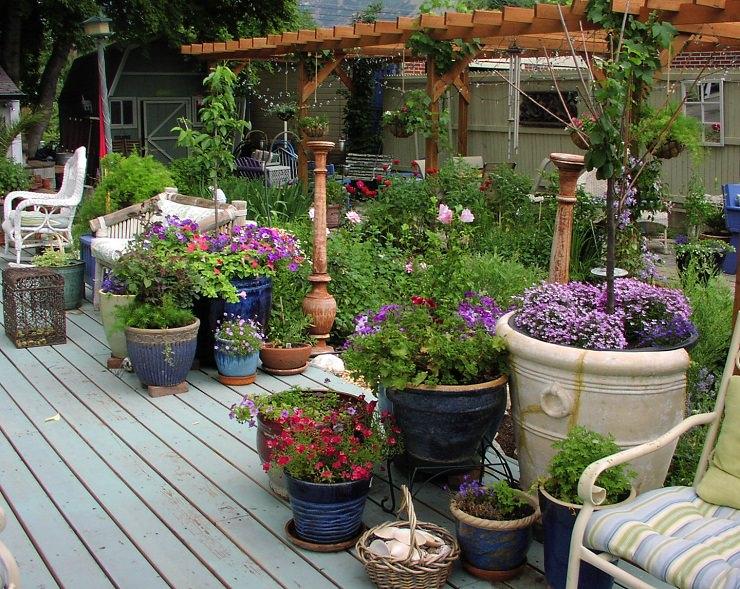
If you want bushier growth, pinch the tips of young plants. Also, many flowering plants require “deadheading”, which means picking and removing the old flowers to promote new ones. You will know when to remove them once the flowers start to fade or wilt or turn brownish.
Potted plants require pruning too and on time, some of the fruits and flowering plants produce only on new branches, so if you must not ignore pruning.
13. Exposing to extreme temperatures
If you research carefully about the plants you’ll find how much temperature (maximum or minimum) they tolerate best. In winters, if require, it is good if you protect such plants by keeping them indoors or in a greenhouse.
If you’re living in a warm climate where summers are hot, protect your plants from the intense sun in summer.

1. Overwatering
Many new gardener believes that the more they water the better. All plants (including non-potted plants) have the different watering needs and *those needs may also vary depending upon the time of the year or season, the amount of light and ambient temperature. The easiest solution to avoid this problem is knowing the moisture level required by each plant.
The majority of plants (except moisture loving plants) loves when the top surface of the substrate dries out between the watering spells, others require the soil to be kept slightly moist. A good method is to usually poke your finger into the soil about an inch deep and feel if it is wet or rather dry.
2. Underwatering
It is equally harmful to the plants. Back to the same point, it is essential to know the moisture requirements of each plant to keep them healthy. Also, it is obvious, in summer all the plants require more water and you should double the amount of water. When you water your plants, do it thoroughly, so that the entire substrate moisten well and the slight amount of water seeps out from the bottom holes of the pots and then wait for it to dry (with the method of poking your finger) and then water again.
3. You do not know everything about the plant
No two plants are identical. The number one thing you should do is read the instructions that come with the plant you have acquired. Always, when you purchase plants in the nursery ask them about the growing requirements. Whenever you get a new plant search about it thoroughly on the web. There are many gardening websites (ours too) and blogs of enthusiastic gardeners who have excellent information about plants.
4. Too little or too much sunlight
Yo might be wrong if you think all plants love the sun, there are some that require shade or part shade. According to experts, the plants themselves can tell us if they are getting the right amount of light or not. For example, the leaves may change color or become scorched or brownish if they are getting too much sunlight. On the other hand, if you notice that your plant is “stretching its neck” toward the light or the leaves are excessively bigger then they definitely need more light. One thing to be noted is that when the warm climate plants are grown in colder zones (whether they are grown there in full or part sun) they require full sun. Similarly, the temperate plants in warm tropics grow best in part sun or shade.
5. Moving or changing position of plants
Plants get used to the place they are placed on and do not like being moved constanly. If one of your plants is thriving correctly under certain temperatures and conditions, avoid moving it to another place as it could make difficult for the plant to adapt to its new place.
6. Incorrect soil

Each plant species has different planting needs and soil requirements. It is recommended that you do proper research about the soil type before planting any plant. However, in containers, well-draining soil is used to avoid root rot. You can make your own light and crumbly soilless mix or buy an organic potting mix of good quality.
7. No transplanting
Potted plants may feel “subjected” to their containers. The majority of them outgrow their pots over a period of about one to two years (depending on how quickly they grow), so it is important that you transplant them into a larger container with fresh and well-nourished potting soil. You can prune the roots of your plants if you don’t want to change their existing pot.
One of the signs to know when to transplant is when the leaves turn yellow, the plant stops growing or seems thirsty and requires water again and again. Even in some cases, you can see that the roots are coming out from the drainage holes.
8. Ignoring the pests
Some of the most common pests that can affect your potted plants are aphids, spider mites, scales, whiteflies and mealybugs. You can prevent pests from attacking your container garden with some techniques. Whenever you buy a new plant scrutinize it to see any sign of pests or diseases. Keep an eye on diseased or weak plants or the ones that are in stress; pests prefer to attack such plants. Look at the inside of leaves and tips of the plants, these are the parts that pests infest most. If pests are already damaging your plants, first identify what type of pests they are and then treat them appropriately, prefer organic pesticides.
9. Carelessness
Are you going on a vacation? It is good for you but not for your potted plants. Be sure to make arrangements for them. Ask someone to come and water the plants when you are away. Another option is to use self-watering containers, they are great especially if you’re a busy person and often forget about watering your plants.
10. Less or no fertilizer
Potted plants depend on soil nutrients and can often require supplements to grow better and healthy besides improving the production of flowers and fruits. Using a balanced fertilizer (easily available) regularly and according to the package instructions, you can ensure that your plants are getting all the nutrients they need. While most of your plants do well with balanced fertilizer, there may be some that require specific combination of nutrients.
11. Overfertilization
Overfertilization can also harm your plants. It can even kill them. Fertilizers when used in excess can damage the roots. If you see the symptoms like yellowing and wilting of lower leaves, browning leaf tips and its margins, defoliation, slow or no growth then it is possible that your plant is suffering from overfertilization.
12. No pinching, deadheading, and pruning

If you want bushier growth, pinch the tips of young plants. Also, many flowering plants require “deadheading”, which means picking and removing the old flowers to promote new ones. You will know when to remove them once the flowers start to fade or wilt or turn brownish.
Potted plants require pruning too and on time, some of the fruits and flowering plants produce only on new branches, so if you must not ignore pruning.
13. Exposing to extreme temperatures
If you research carefully about the plants you’ll find how much temperature (maximum or minimum) they tolerate best. In winters, if require, it is good if you protect such plants by keeping them indoors or in a greenhouse.
If you’re living in a warm climate where summers are hot, protect your plants from the intense sun in summer.
4
5
文章
Hande Salcan
2017年05月23日


One of the hardest decisions a new gardener must make is where to buy their garden seeds and supplies.
Here at The Garden Glove, we have several favorite seed catalogs and suppliers, and we update this list every January. This list has been updated for 2017. Here is some info on our top picks that we use ourselves, and our experience with them, along with their website information. Log onto their websites and request their catalogs today to have seeds in time for spring planting! Or order online like I do… And check out our favorite choices for buying live plants online at the end!
Update: Some companies, in order to save on waste, no longer print paper catalogs… Their catalogs are online only. While I do love curling up with a cup a tea and a stack of catalogs, consider doing the same with a tablet. I encourage companies to save all the trees they can, and besides… you get faster service with online ordering anyway!
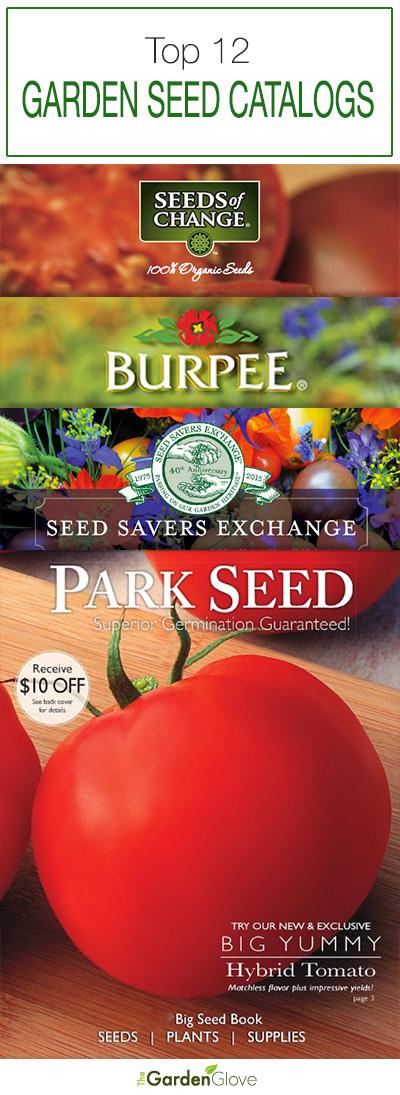
#1
Park Seed
Park Seed always has a great selection of both flower and vegetable seeds, and some great herbs as well. Prices are affordable, and seed packets have plenty of seeds. Seed is always fresh, and we get good to excellent germination rates from them. Shipping is fast, usually just a couple of days from order to in my mailbox! Highly recommended. They also offer some live plants as well.
#2
Burpee Seeds
Burpee has always had one of the most colorful catalogs, and a wide selection of seeds. They are especially good at their vegetable selections, so all you veggie gardeners, take note! Their new varieties are the ones to beat each year!
#3
Thompson and Morgan
Thompson and Morgan is an English seed supplier, but the ultimate in unusual seeds for the serious gardener. If gardening is your passion, you need this catalog.
#4
Johnnys Selected Seeds
As recommended by a reader, this company needs to be added to our list! Not only do they have an extensive seed catalog, they have lots of tips and resources there as well. Johnny has a longstanding reputation as a quality company in the gardening community! Oh, and it’s an employee owned company!
#5
Pinetree Garden Seeds
Pinetree Garden Seeds was one of the first seed companies I ever used. They specialize in smaller packets for the average home gardener, at smaller prices. Most of us will never need the hundreds of seeds in the average seed packet, so why pay for it? They have a good selection, fast shipping and good customer service.
#6
Renee’s Garden Seeds
Renees Garden has grown into one of the most trusted suppliers of seeds for organic and heirloom varieties… So if you crave a little history with your salad, this is the spot for you!
#7
Select Seeds
If you grow flowers and want antique varieties your grandmother grew, this is the place. I love the idea of nostalgia in the garden…so did Thomas Jefferson, one of the most eminent gardeners in our country’s history.
#8
Seed Savers Exchange
Seed savers is a non profit company that is a wonderful source of information on heirloom and open pollinated seed, as well as one of the top sources for such seeds. Not only does the free catalog list all their seeds, their sites educates us on why it is important to save heirloom varieties, and even has an online garden planner that’s got a 30 day free trial. (No, you don’t have to give your credit card!) This is a time honored company and trusted company worth looking into if you wish to preserve our heritage plants!
#9
Seeds of Change
Going organic in the New Year? Seeds of Change is a catalog you need for your veggie garden. Great selection of 100% certified organic seeds.
#10
Cooks Garden
Are you a gourmet cook, or just want to be? Cooks Garden has veggie varieties that are difficult to find on your garden center rack… amazing in flavor and color… Beautiful catalog!
#11
Nichols Garden Nursery
This is a family owned business that has a stellar reputation for quality and customer service. They do not sell any seed that has been genetically modified, and they specialize in fine and rare seeds, herbs and goods for the gardener cook. Love their amazing selection!
#12
Bountiful Gardens
We wanted to include this selection this year because this company is a product of Ecology Action, a not for profit that teaches sustainable agriculture to end world hunger… Their catalog is full of great growing tips, and all their seed is heirloom, non GMO, and certified organic. To quote their website “It doesn’t take much to get started, no gizmos or expensive equipment. If you have some soil, all you need is simple tools, seeds, and the information to use them.”
Order some catalogs today, or visit their online catalogs for faster service, and start dreaming of your spring garden!
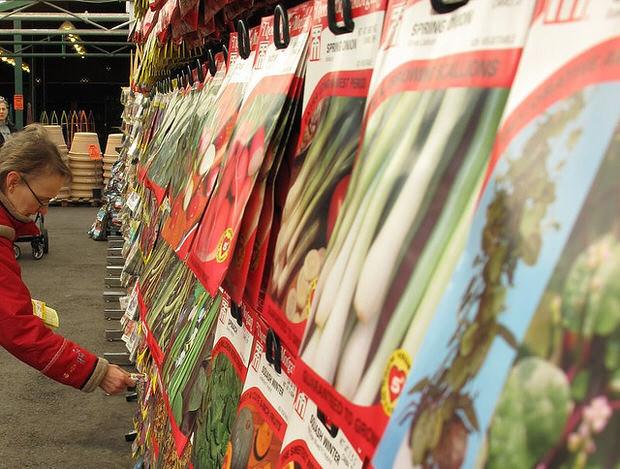
Plants
If you want to order top quality, affordable perennials and shrubs, I highly recommend Bluestone Perennials. I have ordered from them again and again, and never been disappointed. Check their internet specials often!
White Flower Farms has top of the line plants for decent prices, and partners with the like of Family Circle and BHG.
If you are looking for the latest varieties or unique plants, Wayside Gardens is the place… can be a little pricey, but thats because they offer varieties and quality seldom found online.
2
2
文章
Carol
2017年05月23日

Corten steel landscaping is a new way to design a garden. Check these 16 ideas for inspiration.What is Corten Steel?
Also called the weathering steel, cor-ten steel is maintenance free. It is developed to eliminate the need for painting. It is a group of steel alloys that form a stable rust-like appearance if exposed to the weather for several years. Read more about corten steel on Wikipedia.
“By forming a film of dark brown oxidation over the metal, Cor-Ten successfully resists the corrosive effects of weather conditions such as rain, snow, ice, and fog. In this way, the protective layer prohibits deeper penetration of the elements and eliminates the need for painting and the expense of rust-prevention maintenance over the years, saving both money and time.” If you don’t know much about corten steel landscaping, read this informative post.
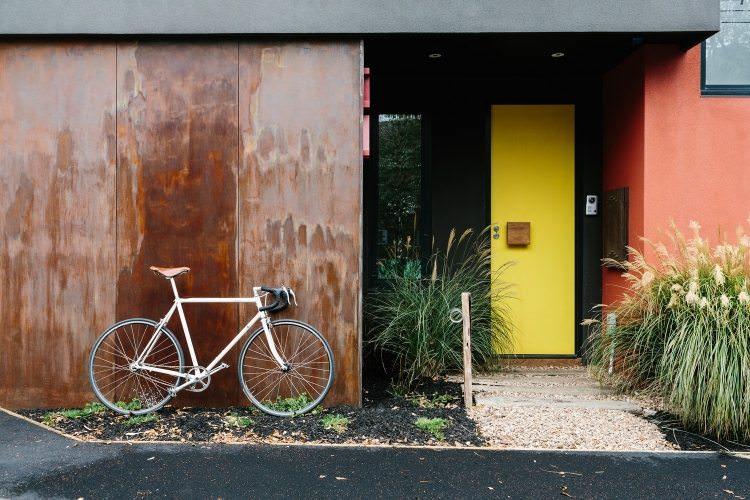
In the past, the rust was estimated as an avoidable and undesirable thing. But now with the use of corten steel, a rusted appearance is possible: A door or furniture, a garden fence or a railing made of corten steel is appreciated by the landscapers and designers, especially in contemporary gardens.
Landscaping with Corten Steel
Here you’ll find 16 creative and inspiring ideas related to Corten steel landscaping in the garden.
1. Corten Steel Fence
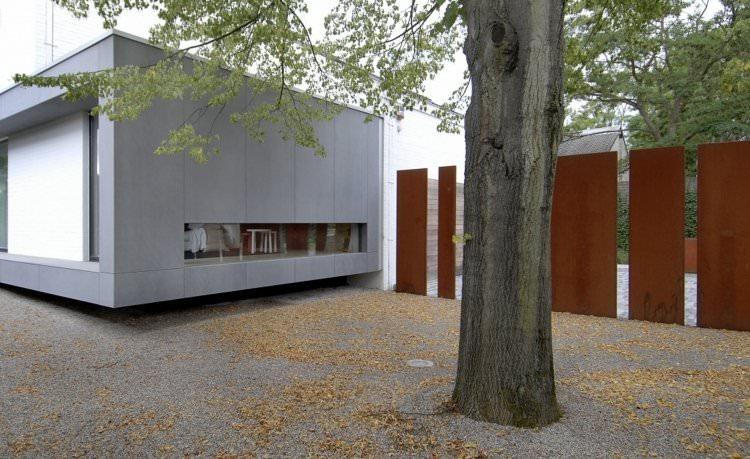
The Corten steel is a material with multiple applications both practical and aesthetic. For example, modern Corten steel fence can be made in large panels.
A Corten steel fence like this will enhance the design of the exterior and make your time in the garden more enjoyable. It is very suitable for outdoor space and brings a touch of naturalness and modernity.
2. Corten steel fence and visual barrier
The protection and privacy are of the paramount importance. To protect yourself from prying eyes, fix a Corten steel barrier which, besides its decorative function, also acts as a fence.
3. The Corten steel in the garden – a material that has multiple applications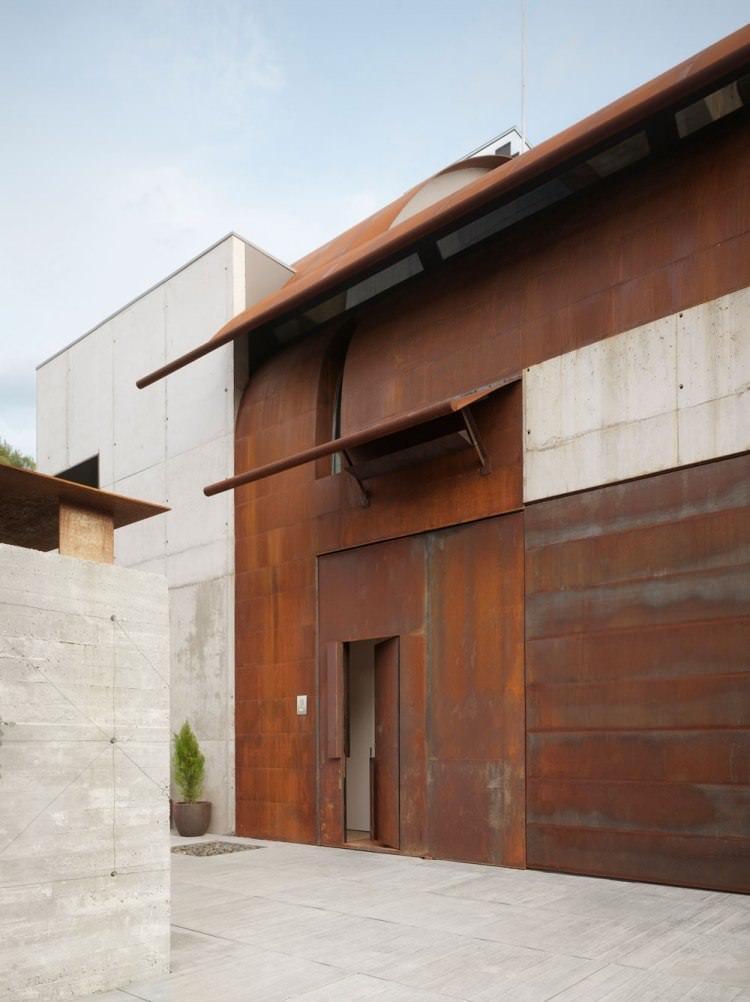
Corten steel has the appearance not only an aesthetic, but it is also resistant to atmospheric conditions. It is almost maintenance free. Under the top layer of rust, there is a special protective layer that prevents the corrosion in it.
4. Corten steel fence made of the reinforcing braided rods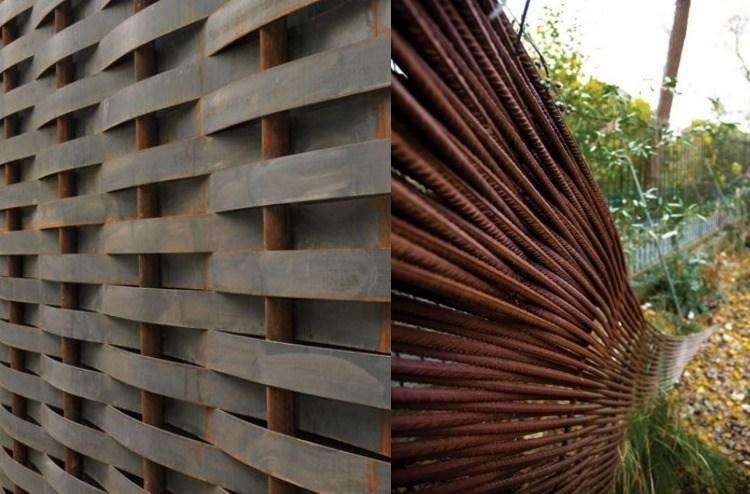
A braided fence made of several reinforcing rods is used to replace the ordinary fence, without cluttering the garden and without reducing the ventilation.
5. Decorative corten steel fence
The Corten steel fence is the contemporary version of the metal fence. It is used with concrete or other material.
6. Corten steel garden gate, eye-catching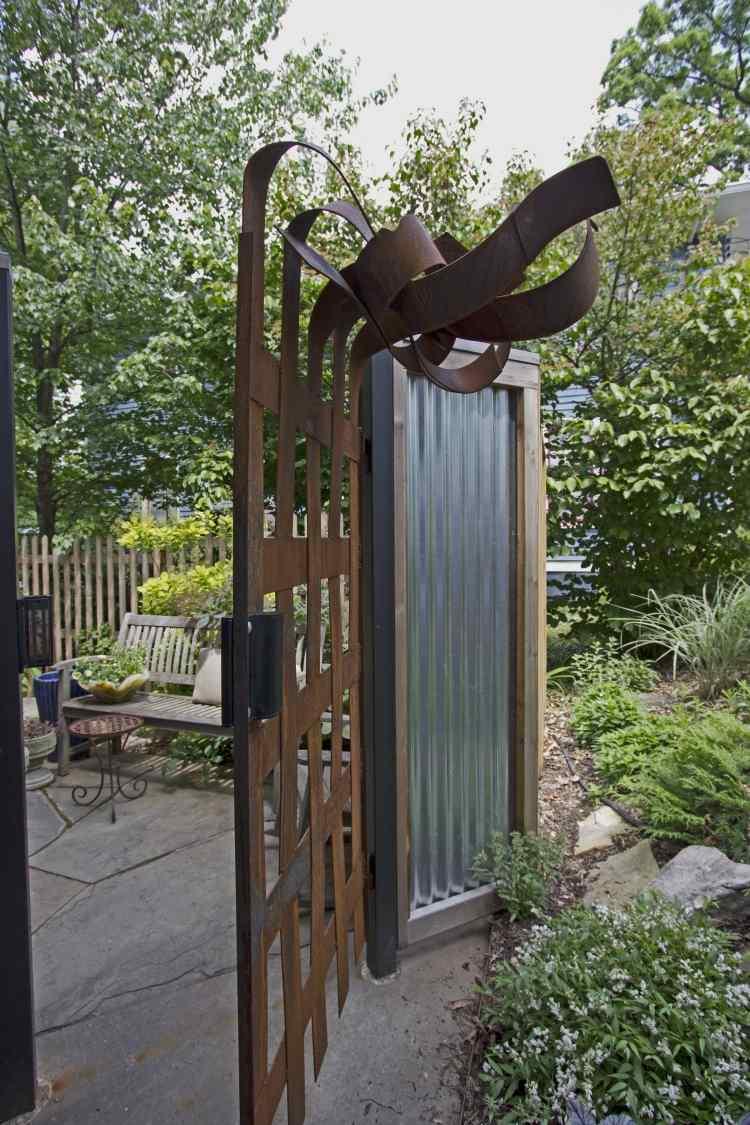
If you are looking for a catchy element with rustic style, get yourself a garden gate made of Corten steel to enhance the look of your outdoor space. These type of doors and gates are in fashion. What you have to do only is to choose the design that best fits for your garden.
7. Corton steel entrance door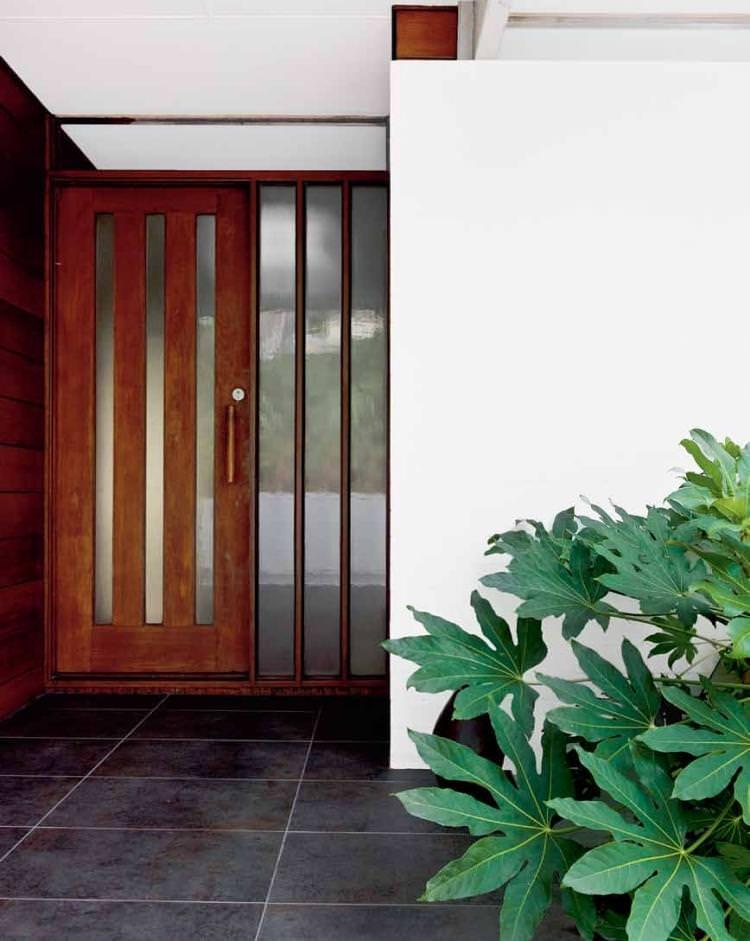
Rusted door and clean floor do not match each other or quite the contrary?
8. Corton steel walkway
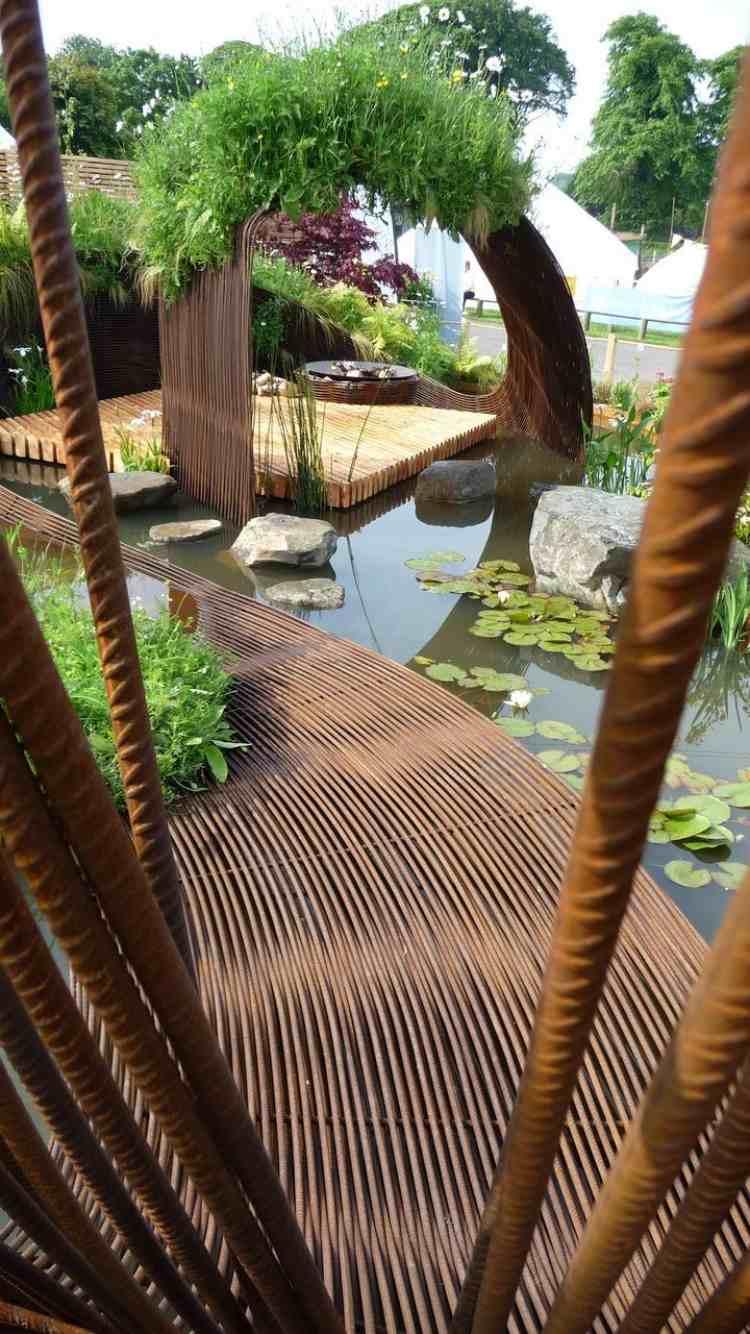
A corten steel walkway can be a good idea to implement. A rustic garden path will look good and be of low maintenance.
9. Corten steel risers to sublimate the steps of the outside staircase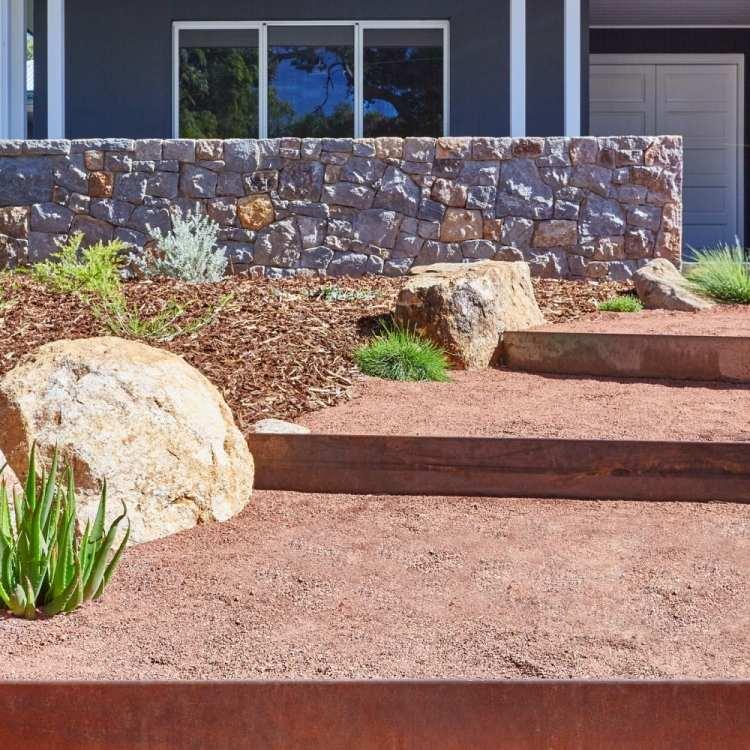
The gross appearance of Corten steel is ideal for rock gardens. This material can be used as risers or for edging.
10. Veranda with a seemingly “rusty” landscape with cor-ten steel raised beds

Combine Corten steel and wood and you will not regret your choice. These materials combine wonderfully and create an atmosphere that is both rustic and modern.
11. Corten steel edging for landscaping
The role of garden borders is to separate the planting beds. Create a rusty steel edge that will be low maintenance too.
12. Corten steel raised beds for ornamental garden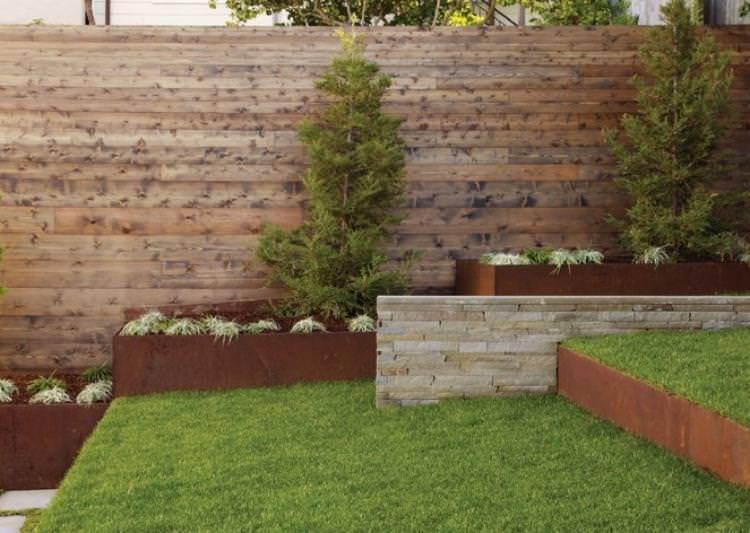
Most of the modern gardens are landscaped with raised beds made of Corten steel, which house the ornamental plants and grasses.
13. Corten steel water feature
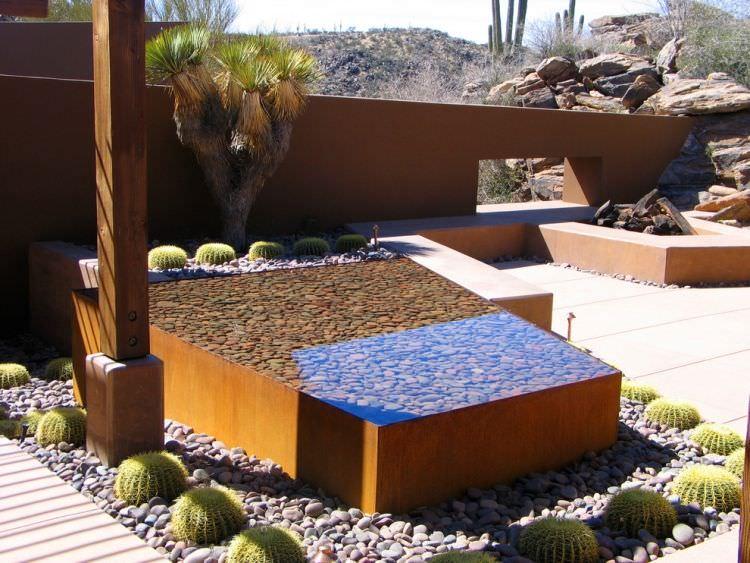
Get inspired by the design of this Corten steel water feature filled with rocks. The lush vegetation brings freshness and makes the garden a true paradise.
14. Garden sculpture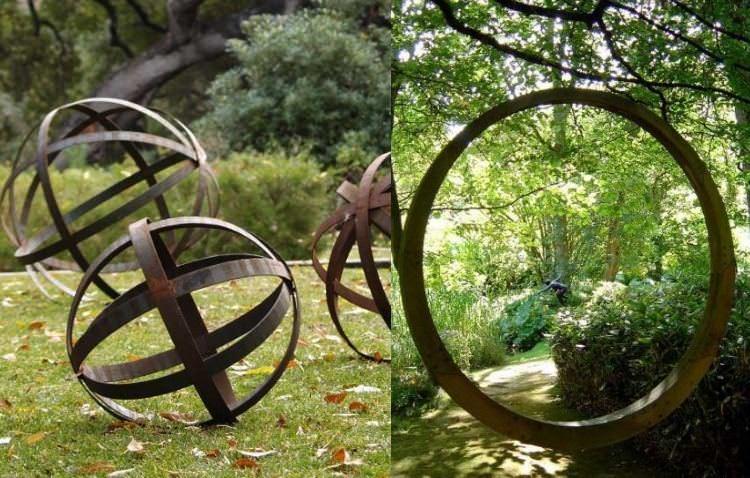
Such a sculpture made of corten steel can completely change the design of your garden.
15. Corten steel brazier or other accessories
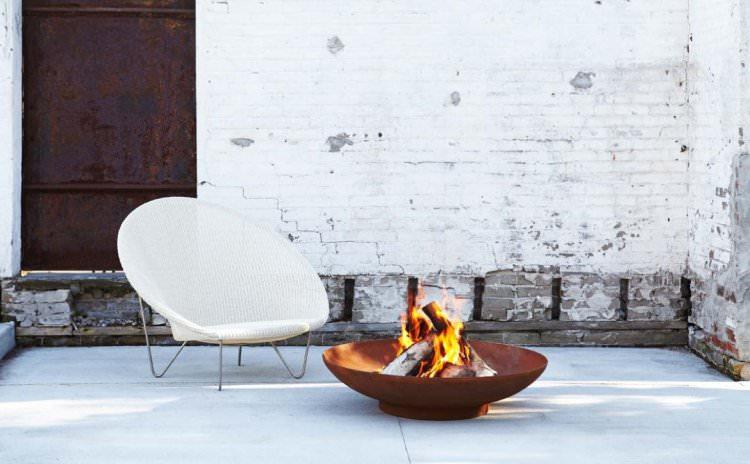
Also called the weathering steel, cor-ten steel is maintenance free. It is developed to eliminate the need for painting. It is a group of steel alloys that form a stable rust-like appearance if exposed to the weather for several years. Read more about corten steel on Wikipedia.
“By forming a film of dark brown oxidation over the metal, Cor-Ten successfully resists the corrosive effects of weather conditions such as rain, snow, ice, and fog. In this way, the protective layer prohibits deeper penetration of the elements and eliminates the need for painting and the expense of rust-prevention maintenance over the years, saving both money and time.” If you don’t know much about corten steel landscaping, read this informative post.

In the past, the rust was estimated as an avoidable and undesirable thing. But now with the use of corten steel, a rusted appearance is possible: A door or furniture, a garden fence or a railing made of corten steel is appreciated by the landscapers and designers, especially in contemporary gardens.
Landscaping with Corten Steel
Here you’ll find 16 creative and inspiring ideas related to Corten steel landscaping in the garden.
1. Corten Steel Fence

The Corten steel is a material with multiple applications both practical and aesthetic. For example, modern Corten steel fence can be made in large panels.
A Corten steel fence like this will enhance the design of the exterior and make your time in the garden more enjoyable. It is very suitable for outdoor space and brings a touch of naturalness and modernity.
2. Corten steel fence and visual barrier

The protection and privacy are of the paramount importance. To protect yourself from prying eyes, fix a Corten steel barrier which, besides its decorative function, also acts as a fence.
3. The Corten steel in the garden – a material that has multiple applications

Corten steel has the appearance not only an aesthetic, but it is also resistant to atmospheric conditions. It is almost maintenance free. Under the top layer of rust, there is a special protective layer that prevents the corrosion in it.
4. Corten steel fence made of the reinforcing braided rods

A braided fence made of several reinforcing rods is used to replace the ordinary fence, without cluttering the garden and without reducing the ventilation.
5. Decorative corten steel fence

The Corten steel fence is the contemporary version of the metal fence. It is used with concrete or other material.
6. Corten steel garden gate, eye-catching

If you are looking for a catchy element with rustic style, get yourself a garden gate made of Corten steel to enhance the look of your outdoor space. These type of doors and gates are in fashion. What you have to do only is to choose the design that best fits for your garden.
7. Corton steel entrance door

Rusted door and clean floor do not match each other or quite the contrary?
8. Corton steel walkway

A corten steel walkway can be a good idea to implement. A rustic garden path will look good and be of low maintenance.
9. Corten steel risers to sublimate the steps of the outside staircase

The gross appearance of Corten steel is ideal for rock gardens. This material can be used as risers or for edging.
10. Veranda with a seemingly “rusty” landscape with cor-ten steel raised beds

Combine Corten steel and wood and you will not regret your choice. These materials combine wonderfully and create an atmosphere that is both rustic and modern.
11. Corten steel edging for landscaping

The role of garden borders is to separate the planting beds. Create a rusty steel edge that will be low maintenance too.
12. Corten steel raised beds for ornamental garden

Most of the modern gardens are landscaped with raised beds made of Corten steel, which house the ornamental plants and grasses.
13. Corten steel water feature

Get inspired by the design of this Corten steel water feature filled with rocks. The lush vegetation brings freshness and makes the garden a true paradise.
14. Garden sculpture

Such a sculpture made of corten steel can completely change the design of your garden.
15. Corten steel brazier or other accessories

0
0




